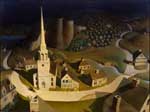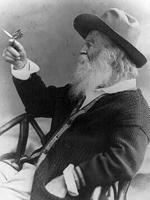Teaser
Did Revere's ride really look like that? Use historical documents to analyze flights of artistic fancy.
Description
Students assess a famous artistic depiction of Paul Revere's ride, based on historical documents.
Article Body
This lesson asks students to use primary source evidence to assess Grant Wood’s famous 1931 painting, The Midnight Ride of Paul Revere. Students must also determine the event's historical significance. This lesson offers a wealth of resources for analyzing artwork as historical evidence and provides a nice example for using artwork along with written documents to learn about the past.
The lesson opens up by asking students to note their initial impressions of Wood's painting. Additional resources are included to help students analyze the painting.
Following the opening activity, students read a series of primary accounts of the event from the British perspective and the colonial perspective. Teachers should consider the lesson plan’s suggestion to jigsaw this activity since the documents range in length and difficulty.
The lesson concludes with multiple assessment options including analyzing the poem "Paul Revere's Ride" by Henry Wordsworth Longfellow, using evidence to distinguish between fact and fiction, and writing a short story. Teachers could also easily create a document-based question assignment to assess students' historical understanding.
Topic
Paul Revere’s Midnight Ride and Analyzing Paintings
Rubric_Content_Accurate_Scholarship
Rubric_Content_Historical_Background
Yes
A wealth of background information is included about Revere's ride as well as relevant poetry and artwork.
Rubric_Content_Read_Write
Yes
Students are asked to read primary and secondary sources and write from the perspective of the historical actors.
Rubric_Analytical_Construct_Interpretations
Yes
Students analyze artistic interpretations of the past and construct historical interpretations of the past.
Rubric_Analytical_Close_Reading_Sourcing
Yes
Students are asked to consider the author’s perspective as they read and analyze primary sources.
Rubric_Scaffolding_Appropriate
Rubric_Scaffolding_Supports_Historical_Thinking
Yes
Includes guiding questions that scaffold thinking. However primary documents may need further editing and preparation depending on students' reading levels.
Rubric_Structure_Assessment
Yes
Multiple assessment options
Rubric_Structure_Realistic
Rubric_Structure_Learning_Goals



